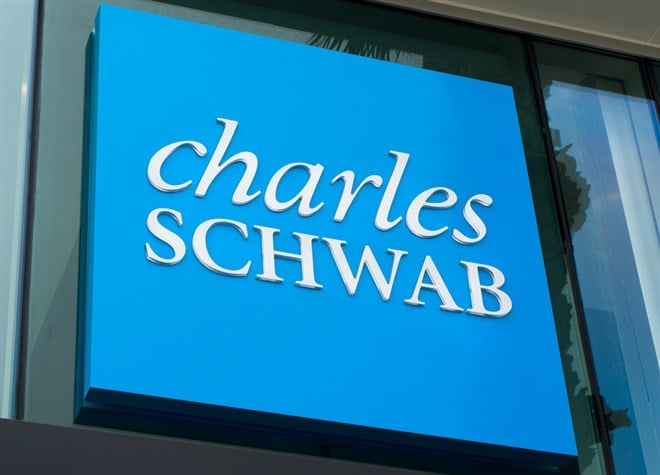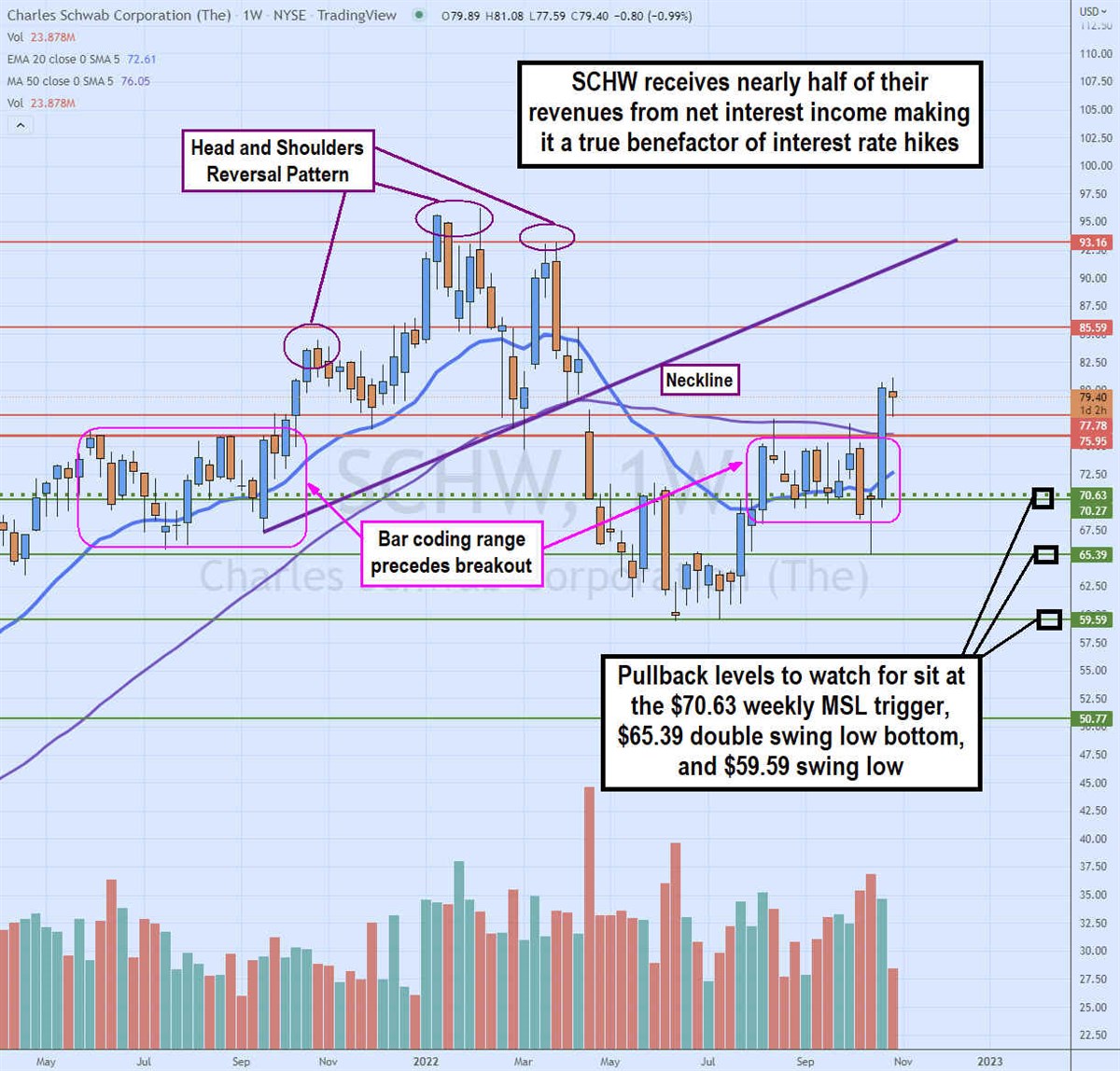 Charles Schwab (NYSE: SCHW) has evolved beyond its humble beginnings as a discount broker. Even before the advent of the internet, Schwab’s niche was offering its discount brokerage services to retail investors at a cheap one-price commission garnering nearly a 51% market share of retail investors. Whereas a commission on trade could cost upwards of $150 to $300 or more at a full-service brokerage depending on the size of the transaction, it would only cost a flat $30 at Schwab. Full-service brokers administered investment advice, and provided research and recommendations, while discount brokers only offered discount commissions with no advice. For retail self-directed investors, the savings was a stark contrast. Schwab’s human brokers worked on salary, not commission like full-service brokers. The line between full-service and discount was very obvious back then
Charles Schwab (NYSE: SCHW) has evolved beyond its humble beginnings as a discount broker. Even before the advent of the internet, Schwab’s niche was offering its discount brokerage services to retail investors at a cheap one-price commission garnering nearly a 51% market share of retail investors. Whereas a commission on trade could cost upwards of $150 to $300 or more at a full-service brokerage depending on the size of the transaction, it would only cost a flat $30 at Schwab. Full-service brokers administered investment advice, and provided research and recommendations, while discount brokers only offered discount commissions with no advice. For retail self-directed investors, the savings was a stark contrast. Schwab’s human brokers worked on salary, not commission like full-service brokers. The line between full-service and discount was very obvious back then The Poor’s Man’s Broker
For decades, Schwab had the stigma of being the poor kid in the lunch line with a reduced-price lunch ticket. Schwab was the embarrassing poor man’s alternative to blue shoe full-service investment bank brokerages including Goldman Sachs (NYSE: GS), Morgan Stanley, Merrill Lynch, Lehman Brothers, Bear Stearns, and Salomon Smith Barney. The establishment was completely shaken up by the 2007 financial crisis causing the unthinkable as Lehman Brothers went bankrupt and Bear Stearns was acquired for pennies on the dollar by JP Morgan (NYSE: JPM). Merrill Lynch was swallowed up by Bank of America (NYSE: BAC). Salomon Smith Barney had been acquired by Morgan Stanley (NYSE: MS). Schwab evolved to grow its online presence and include independent research, recommendations, asset management services while full-service brokers started cutting commissions as the line between full-service and discount continue to blur.
Here’s Why the TD Ameritrade Acquisition Was Brilliant
Fast forward to the electronic age of financial markets. Schwab was the first of the major discount brokers to make the transition to zero-commission stock trades to blunt rival Robinhood (NASDAQ: HOOD) and fintech apps like Sofi Technologies (NASDAQ: SOFI) acquiring retail investors and traders with its no-commission trades, simple and gamified interface, and a multitude of services. They made perhaps one of its best moves in acquiring TD Ameritrade in 2020 despite the COVID pandemic. The acquisition brought in $121 billion in new core assets with 1.2 million new brokerage accounts that averaged nearly 6.5 million daily trades. Most considered this a play on bolstering its active trader base with the addition of Ameritrade including the Think or Swim trading platform. This would complement its nearly two-decade-old acquisition of electronic trading firm Cybertrader. However, in a bear market, the additional assets helped pump its profits from net interest rate income and conversion to wealth and asset management services while active trading volume fell. In hindsight, it was one of the most brilliant moves in the financial services industry as Schwab fully transformed itself into a complete one-stop shop for investors and traders. This prompted Morgan Stanley to acquire E*TRADE to bolster its retail base of investors and traders. Schwab also elevated its reputation and status and stock price as it continued to dominate the market share of retail investors. Trading revenues only account for 18% of total revenues. The addition of the retail customer base and assets from the TD Ameritrade acquisition helped to prop up net interest income to 51% of total revenues and asset management and administration fees to 21% of total revenues.

Watch These Levels on the Weekly Chart
SCHW chopped around in a barcode pattern between the $65.73 to $76.35 range until a breakout triggered to the $84.48 peak forming the first shoulder. Shares bounced off the $76.46 pullback lows to resume their uptrend to peak at $96.24 on the weekly chart to form the head. After a pullback to the $74.63 level. The bounce to a lower high of $93.16 level formed the shoulder before shares fell back down to break the neckline at $79.50 to complete the weekly head and shoulders bearish breakdown pattern. SCHW collapsed all the way down to the $59.59 swing low by June 2022. SCHW was able to rally on the $70.63 MSL trigger breakout before chopping again in a barcode pattern between $68.30 to $77.30 range until a breakout formed on heavy volume in reaction to its Q3 2022 earnings. Upside resistances hit at the $85.59 and $93.16 double top area. Pullback levels to watch sit at the $70.63 weekly MSL trigger, 65.29 double recent swing low bottom and the $59.59 swing low.
Strongest Quarter in History
On Oct. 17, 2022, Schwab released fiscal Q3 2022 results for the quarter ending in September 2022. The Company reported an earnings per share (EPS) profit of $1.10 versus $1.05 consensus analyst estimates, beating by $0.07. Revenues grew 20.4% year-over-year (YoY) to $5.5 billion, beating analyst estimates for $5.4 billion. This marks the strongest quarter in Company history which is very impressive considering it was accomplished during a bear market.
Schwab Prospers in Both Bull and Bear Markets
Schwab CEO Walt Bettinger commented, “Our modern wealth management approach provides a wide array of investing and financial capabilities to support investors through a range of market conditions, particularly in difficult times like these.” CEO Bettinger continued, “Equity markets remained under pressure throughout the quarter including the largest percentage drop for a September since 2008 with the S&P 500 extending its year-to-date losses to 25%. The Federal Reserve assumed an increasingly hawkish stance, tightening monetary policy at the fastest rate in four decades, as it wrestled with elevated inflation and lingering effects from the global pandemic.“ He noted that the daily average trading volume was flat at 5.5 million trades with the same period last year, which is not bad considering last year was a raging bull market while this year is the complete opposite. Schwab wins in both bull and bear markets. In bull markets, Schwab gains from trading volumes and management fees on growing asset values. In bear markets, Schwab gains from growing net interest income from interest rate hikes. Rising markets should improve trading volumes and wealth management revenues, while Schwab is more than hedged against falling markets with rising net interest income from fed rate hikes. This is evidenced by having the strongest quarter in the Company’s history thanks to rate hikes.













